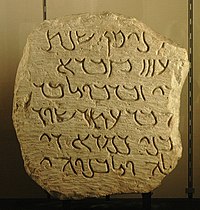Palmyrene Aramaicwas aMiddle Aramaicdialect, exhibiting bothEasternandWestern Aramaicgrammatical features, and is therefore often regarded as adialect continuumbetween the two branches.[a]It was primarily documented inPalmyraitself, but also found in thewesternparts of theRoman Empire,extending as far asBritannia.Dated inscriptions range from 44 BCE to 274 CE, with over 4,000 known inscriptions, mostly comprising honorific, dedicatory, and funerary texts. The dialect still retains echoes of earlierImperial Aramaic.The lexicon bears influences from bothKoine Greekand, to some extent,Arabic.[7][8][9]
| Palmyrene Aramaic | |
|---|---|
| Palmyrean[1] | |
 Limestone funerary slab | |
| Region | Syrian Desert |
| Extinct | 1st millennium |
Early forms | |
| Palmyrene Alpha bet | |
| Language codes | |
| ISO 639-3 | – |
qhy-pal | |
| Glottolog | None |
Thedualhad disappeared from it.[7]
The written Palmyrene language was composed in a rounded script that later exhibited resemblances to theSyriac Estrangelascript.[10]
See also
editReferences
edit- ^"Palmyrean".LINGUIST List.Archived fromthe originalon 8 October 2020.Retrieved20 November2024.
- ^Tempus, Aspekt und Modalität im Reichsaramäischen(in German). Harrassowitz. p. 47.
While the East Aramaic Palmyrene language seamlessly supplanted Imperial Aramaic as the language of Palmyra, likely in the second century BCE.…
- ^Aramaic Inscriptions and Documents of the Roman Period.OUP Oxford. p. 43.
…Palmyrene was a continuation of Official Aramaic and a close reflection of the spoken language of the Palmyrene region, with eastern Aramaic features….
- ^Die aramäischen Achikar-Sprüche aus Elephantine und die alttestamentliche Weisheitsliteratur(in German). Walter de Gruyter. 2010. p. 649.ISBN9783110212082.
Sie ist sonst erst wesentlich später in ostaramäischen Dialekten (etwa im Palmyrenischen) bezeugt.
- ^Hellenistic and Roman Greece as a Sociolinguistic Area.John Benjamins Publishing Company. p. 271.
…Palmyrene Aramaic has preserved many old Aramaic features; on the other hand, it also shows isoglosses with the eastern dialects…
- ^King, Daniel (12 December 2018).The Syriac World.Routledge.ISBN9781317482116.
It may be akin to the Eastern Aramaic dialect component in Palmyrene, but the regional element there is often eclipsed by the strong presence of an older literary tradition and defies exact dialectal classification (Gzella 2015a: 250-3).
- ^abCharles Fontinoy (1969).Le duel dans les langues sémitiques(in French). Librairie Droz. p. 76.ISBN9782251661797.
- ^Sebastian P. Brock:Greek and Latin Words in Palmyrene Inscriptions: A Comparison with Syriac,in: Eleonora Cussini (Hrsg.):A Journey to Palmyra. Collected Essays to Remember Delbert R. Hillers(=Culture and History of the Ancient Near East22). Brill, Leiden 2005, 11–25; Holger Gzella:Die Palmyrener in der griechisch-römischen Welt. Kulturelle Begegnung im Spiegel des Sprachkontaktes,in:Klio87 (2005), 445–458; Ders.:Das Aramäisch in den römischen Ostprovinzen. Sprachsituationen in Arabien, Syrien und Mesopotamien zur Kaiserzeit,in: Bibliotheca Orientalis 63 (2006), 15–39.
- ^Mohammed Maraqten:The Arabic Words in Palmyrene Inscriptions,in:ARAM7 (1995), 89–108.
- ^A Corpus of Syriac Incantation Bowls.Brill. p. 15.
... Palmyrene characteristics detectable in its forms. He wrote (1962, 61) that this script may be seen as "a Syriac type evolved from an early form of Aramaic Alpha bet, of Palmyrene type, and which enjoys independence from the Edessene..
Notes
editFurther reading
edit- Daniels, Peter T.(1988).""Shewing of Hard Sentences and Dissolving of Doubts": The First Decipherment ".Journal of the American Oriental Society.108(3): 419–436.doi:10.2307/603863.JSTOR603863.
- Hillers, Delbert R.; Cussini, Eleonora (1996).Palmyrene Aramaic Texts.Johns Hopkins University Press.ISBN978-0-8018-5278-7.
- Hans H. Spoer (1904). "Palmyrene Inscriptions found at Palmyra in April 1904".Journal of the American Oriental Society.
- John Swinton(1753). "An Explication of All the Inscriptions in the Palmyrene Language and Character Hitherto Publish'd. In Five Letters from the Reverend Mr John Swinton, M. A. of Christ-Church, Oxford, and F. R. S. to the Reverend Thomas Birch, D. D. Secret. R. S.".Philosophical Transactions.48:690.Bibcode:1753RSPT...48..690S.